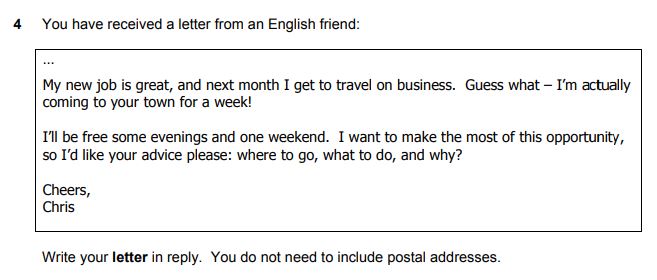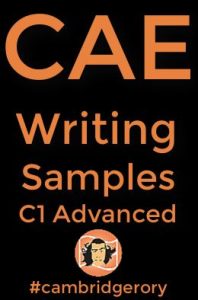Table of Contents
CAE Letter Introduction | CAE
I have a question for you. "What is a CAE Letter?"
A CAE Letter is a part 2 writing task in the C1 Advanced (CAE) exam. In part 2 there are three questions based on 5 different types of writing. Therefore, it is not certain that a letter will appear in the exam. Mathematically, there is a 3 in 5 or 60% chance that it will appear.
I have another question for you. "Do you know how to write a good C1 Advanced letter for the CAE writing paper part 2?"
If your answer is "NO!!!! I have absolutely no fudding idea how to write a C1 Advanced letter" - don't worry, by the time you've completed this page, you'll feel a lot more confident and you will know exactly what to do to prepare yourself in the best way for this writing task.
Make sure you follow the order of the page and don't skip sections because I have organised the page deliberately to help you in a specific way.
If you don't know who I am, you can check out my instagram, youtube or facebook pages to learn more about me. To summarise very quickly, I am your new teacher who believes you can do anything you want! You can pass the CAE exam and you can achieve your BIGGEST goals and ambitions in life. I am here to motivate you and to help you achieve these goals while at the same time saving yourself money and time by working effectively and efficiently!
As a side note, the next time you go shopping, see if you can buy everything you want without buying any plastic at all. I've been doing this recently and although it is very difficult, it makes me feel good and I believe small things like this make the world a better place.
Anyway, back to the topic. Did you notice I used the words "without buying" in the last paragraph?
Do you know why we use a gerund (verb+ing) here?
C1 Advanced Exam Tip: If you write a preposition with a verb immediately after, this verb should end -ing.
Preposition + verbing.
This mistake is exactly what examiners will look for when they are marking your C1 Advanced letter and you may be tested on it in other parts of the CAE exam. While you are reading through my website, I advise you to write these tips down in a small notebook.
I give loads more tips and talk about these topics in a lot more detail in my C1 Advanced course. Alternatively, you can visit my common errors at C1 Advanced pages to see over 150 other typical mistakes real students made in my lessons. You will also learn why they are mistakes and you will see how to correct them.
Examiners’ Marking Criteria
Watch this video closely and make notes of any important points. Understanding how an examiner marks your C1 Advanced letter will make it a lot easier to ACE it in the exam. The marking criteria is the same for every C1 Advanced writing task.
Watch some of my other youtube videos
If you want to help my business and help other students like you find my work, please subscribe to my youtube channel. I'd also love it if you watch, like and comment on my videos. I try my best to reply!
How to write a CAE Letter video transcript and summary
If you found the video above difficult to follow, I have written the most important parts here for you:
Before the Exam:
- Watch the examiner's marking criteria video. - If you've followed this page until now, you've already done this!
- Revise the advice that Cambridge give about writing a C1 Advanced letter. I have written this below (letter advice).
- Practice, practice, practice! The best way to practice is with a coursebook or old exam questions. If you get a good coursebook like the one I suggest in my CAE book review, make sure you cover the vocabulary and grammar sections. These will be really useful for every part of the CAE exam, including the C1 Advanced letter.
- Also, make sure you practise in the conditions you will have in the exam. Plan if you are doing a computer based exam or a written exam and practice accordingly. For paper exams you can write with a pen or pencil.
- Time yourself during practise. Read the question for 2 minutes, make a plan for 5 minutes, write for 30-35 minutes, read over your work for 3-8 minutes (I talk about this time management more in my 'In the exam' section below. However you organise your time, make sure you stop after 45 minutes. Count how many words you have written. Check to see how much of the page your writing fills. There are 2 reasons for this: 1. If you are within the word limit, this will give you a good indication how quickly you need to write in the exam. 2. It will also show you approximately how much you need to write in the exam. Quick tip: don't waste time counting words in the exam.
- Brush up on some of the most common errors which students make at C1 Advanced.
In the exam:
- Take 2 minutes to read the question and underline the vital information.
- Identify the target reader. I show you how to do this in my 'letter question' example below. The target reader is important as it will dictate your style and level of formality.
- Take 5 minutes to plan. Remember who the target reader is and think how you can connect your main points. I have written an example of a letter plan below).
- Ideally, you should spend 30-35 minutes writing your answer. Practice writing 220-260 words in this time period before the exam!
- Often there will be more than 1 particular element to a question. If it asks you to write about 2 points, make sure you write about 2 points.
- Try to develop your ideas. A good way to do this is to ask yourself 'Why did I write that?' I also suggest using the same technique on my CAE Speaking tips and techniques page. If you can give more detail or information try to do so and also focus on how you can link your ideas and paragraphs together.
- Think about the type of language you should use. I have specific 'formal letter vocabulary' and 'informal letter vocabulary' sections later. You get marks for trying to use complicated grammar and vocabulary in the exam. However, if you have no idea how to form a grammatical structure, do not try to use it. You should be fairly accurate, if not perfect.
- If you have followed this strategy so far, you should have 3-8 minutes remaining to check your work. The important thing to focus on is making sure the overall meaning of your points is obvious to the reader.
CAE Letter Advice
The Cambridge C1 Advanced Handbook gives an indication as to who the target reader might be.
Question: Do you think you should write more formally to:
- The director of a company?
- A peer?
Answer: 1. You should write more formally to the director of a company. 'A peer' is somebody you work with or a friend.
This is why it's crucially important to identify the target reader.
When practising for the exam, you should try to find questions aimed at different target readers.
You can write a sample answer for me on this page >>
Alternatively, Write and Improve is a website where you can find sample C1 Advanced letter questions and it also has the ability to mark your writings.
Along with the target reader, this information will also help you decide what type of language you need to use. I will put some useful phrases for formal C1 Advanced letters and informal letters below but remember you can also find useful vocabulary for these purposes in good C1 Advanced books.
When writing a letter, you should use an appropriate beginning and ending.
You can reference a previous letter if appropriate and make sure you use separate paragraphs that have a clear flow. This means one paragraph leads onto the next paragraph nicely.
If you start 'Dear sir/madam', make sure you end the letter 'Yours faithfully'.
If you start 'Dear Mr/Mrs X', end the letter 'Yours sincerely'.
You should also write another line before you end. For example:
"I hope you take my letter into consideration.
Yours faithfully
George" (formal)
or
''Looking forward to your reply.
Take care
Paola" (informal)
I talk more about these things in a lot more detail in my CAE writing course which you can start by registering for my website >>. I have more information dedicated to C1 Advanced letters as well as every other writing task you might face. I also go through and critique sample writings and real examiners commentary.
Quick tip: You will probably write better about a topic which you are interested in or have experience of.
CAE Letter Example - Question, Critique etc.
CAE Letter Question
Read the question below and write on a separate piece of paper which words you would underline if you did this question in the exam.
C1 Advanced Letter Tip: Did you notice I used a second conditional grammar tense in the sentence above for a hypothetical present situation. You may be tested on this in the exam, so here is the form:
subject + would + infinitive...if + subject + past simple (no comma)
or the other way around
if + subject + past simple, subject + would/might/may/could + infinitive
So, which words would you underline in the exam?
Remember this is subjective and so the words you underline might be different to mine. I just underlined the words which I thought were most important.
So, if I decided to answer this question, I would underline these words:
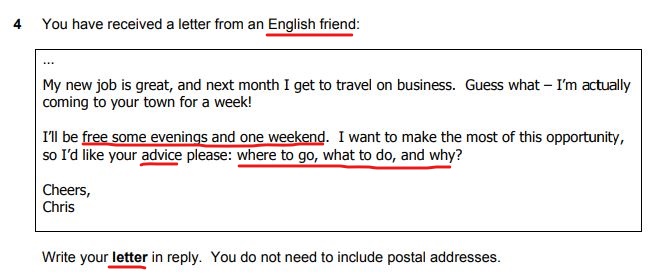
Here are some questions for you to answer based on these underlined words:
- Who is the target reader?
- Are you i) reassuring somebody. ii) giving recommendations. iii) justifying a course of action.
- Is this a formal or informal letter?
Answers
- Your friend Chris.
- This question is trickier. The main purpose is to give advice, which is ii) giving recommendations. Nevertheless, you need to say why you give these recommendations, so i) and iii) will also play a part in the language you use.
- This is an informal letter to your friend.
CAE Letter Plan
You should now write your own plan for the letter question above.
Can you remember how long I suggested to plan in the exam? 2 minutes or 5 minutes? If you think 2 minutes, go back and read the How to write a CAE Letter video section again.
Take 5 minutes to make your plan, just like in the exam. Time yourself.
You could make up some things for your friend to do but in my experience students find it easier to write about real events and places.
When you've done this, you can read my plan.
My Plan
Language: informal and persuasive.
Town: Cambridge.
Format:
Introduction (60 words) -
Opening formality. 'Dear Chris, It's so nice to hear from you...'
First paragraph (80 words) - first suggestion - evening.
What: Punting in the river. Where: city centre. Why: Learn about Cambridge. Nice experience if good weather. 'You'd love it' - encouraging language.
Second paragraph (80 words) - second suggestion - weekend.
What: Go around the university buildings. Where: Various places around city. Why: You're a historian and some of your favourite celebrities studied at Cambridge.
Extra point if needed: evening. What: Go to a pub called 'The Eagle'. Where: City centre. Why: You like to try English beer and traditional food.
Conclusion (30 words) -
We can do one of the activities above together if you like. Closing formality 'Bye for now.'
CAE Informal Letter Answer
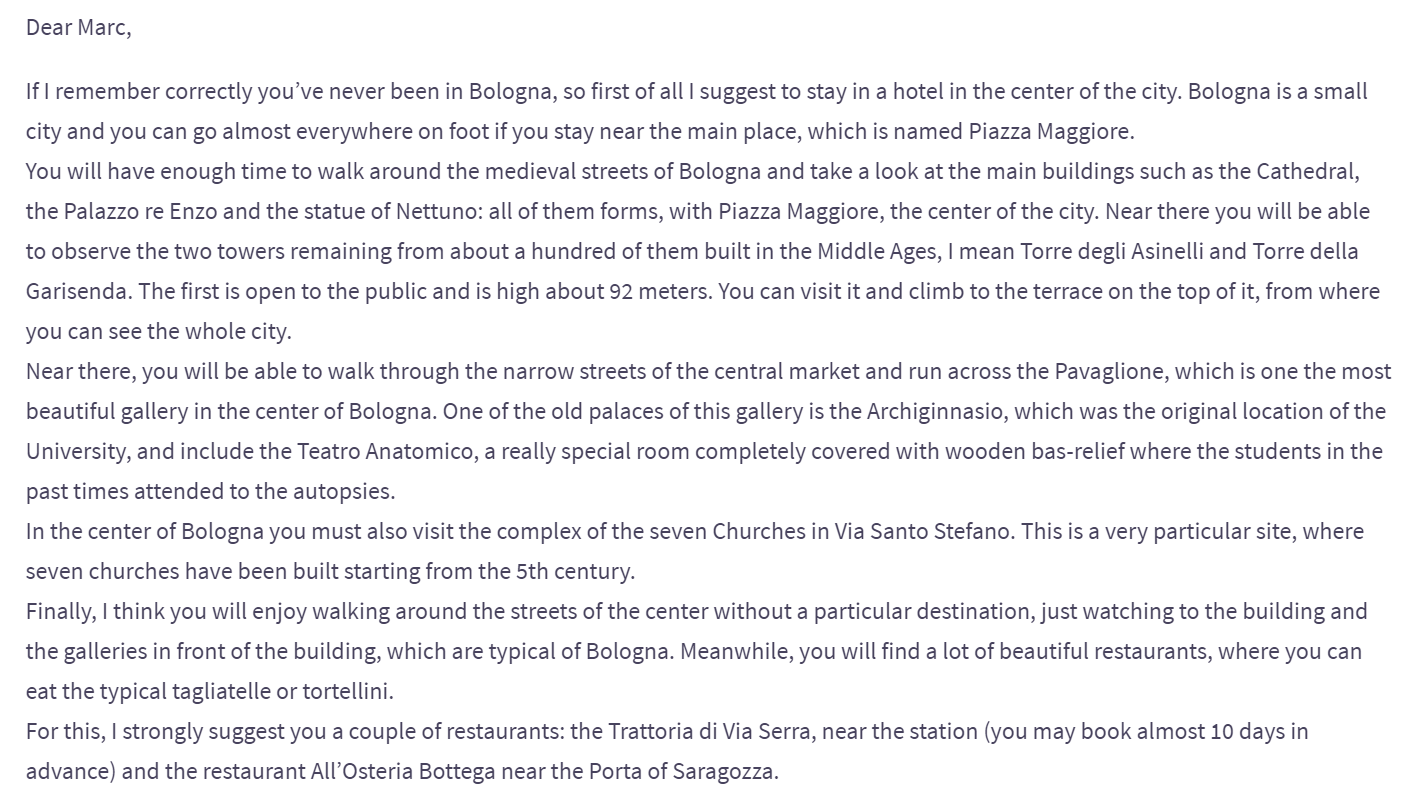
If you want to write a C1 Advanced Letter for me to mark, head over to this page >>
Student's Answer With My Comments
I have made corrections in bold and added comments in brackets (like this).
Dear Marc (this is the wrong name - make sure you write to the person who wrote to you),
If I remember correctly you’ve never been to (when using the verb ‘go’ to indicate movement/travel, it normally collocates with the preposition ‘to’) Bologna, so first of all I suggest -staying (there are a few different uses of ‘suggest’, see this page) in a hotel in the center (this is American English. This is fine, just make sure you are consistent with either American or British English) of the city. Bologna is a small city and you can go almost everywhere on foot if you stay near the main square, which is named Piazza Maggiore (it's more natural to say 'which is called').
You will have enough time to walk around the medieval streets of Bologna and take a look at the main buildings such as the Cathedral, the Palazzo Re Enzo and the statue of Nettuno: all of them along with Piazza Maggiore, form the center of the city (I changed this sentence to make it sound more natural). Near there, you will be able to observe the two remaining towers (put the adjective before the noun) from about a hundred of them, which were built in the Middle Ages. They are called (this is more specific) Torre degli Asinelli and Torre della Garisenda. The first is open to the public and is about 92 meters high (you need to say ‘high’ here). You can visit it and climb to the terrace on the top of it, from where you can see the whole city.
Near there, you will be able to walk through the narrow streets of the old market town and run across the Pavaglione, which is one of the most beautiful galleries (this is a common error, you should read some of my other common errors at C1 Advanced pages) in the centre of Bologna. One of the old palaces in this gallery is the Archiginnasio, which was the original location of the University, and includes the Teatro Anatomico, a really special room completely covered with wooden carvings where students in the past attended autopsies.
In the center of Bologna you must also visit the complex of the seven Churches in Via Santo Stefano. This is a very particular site, where seven churches have been built starting from the 5th century.
Finally, I think you will enjoy walking around the streets of the centre without a particular destination, just looking at (we use ‘watch’ when we are focussing on something for a long time, for example, the television) the buildings and the galleries in front of them (you can use a pronoun here to avoid repeating the same information), which are typical in (this is an example of a collocation, we normally say something is ‘typical in a place’) Bologna. Meanwhile, you will find a lot of beautiful restaurants where you can eat the typical (you could use a different word to ‘typical’ here) tagliatelle or tortellini.
For this reason (make sure you use a noun, also you have given more than 1 reason, so you should say ‘for these reasons’), I strongly suggest visiting a couple of restaurants: the Trattoria di Via Serra, near the station (you should (this is advice) book almost 10 days in advance) and the restaurant All’Osteria Bottega near the Porta of Saragozza.
(You should use a closing statement or phrase).
C1 letter with with my marks and comments on the examiner's assessment scale
Subscale | Mark (1-5) | Commentary |
Content | 3 | All the content is relevant to the task. However, I would be more explicit in stating why you gave each piece of advice. You address what to do and where to go, but perhaps you could give some suggestions of when Chris should do these activities. You could have replied to Chris' comment about his new job at the beginning. Make sure you write your letter to the same person who write to you. Finally, make sure you write a closing sentence and an appropriate ending, e.g.: "See you soon, Paola". |
Communicative Achievement | 3 | The conventions of an informal letter have been used to communicate your ideas (you've never been to Bologna...; I think you will...; you must also...) The advice given is quite easy to understand, but it lacks strong justification and persuasion. Why should Chris visit these places? |
Organisation | 2 | The paragraphs have been clearly separated. However, there is no clear linking between the main points or paragraph. Why does your second paragraph lead to your third paragraph for example. Giving reasons why Chris should follow your advice will help with this. The first paragraph could address Chris' letter more directly rather than giving the first piece of advice. There are no concluding comments and the typical conventions used to finish a letter are absent. |
Language | 2 | There is not a vast amount of complex grammatical structures used. More of these would show greater competence with the language. The language used is fairly neutral and the use of more informal expressions would be more engaging and appropriate for the task. There are some errors in the writing which impede communication at times. It would be good to see some less common words and expressions used. |
Pass or Fail
So, if we add up the marks, the student has scored:
Content: 3/5
Communicative Achievement: 3/5
Organisation: 2/5
Language: 2/5
Total: 10/20.
If you can't remember what these scores mean, go back up and watch the examiner's marking criteria video again.
Remember you need to answer 2 questions in the CAE writing paper.
If this student also got 10/20 for part 1, the essay, they would have 20/40 for the whole writing paper.
This would mean the student would fail this part of the exam as 20 is only equivalent to a B2 and you need 24/40 to pass with C1 in this paper.
If you want to understand more about this and for other C1 Advanced papers, check out this page >> You can use this page to convert your practice test scores and see if you have passed or failed various parts of the exam.
CAE Letter - Sample 2
Question
You have recently sent this to your brother:
“.... Make sure you don't go to Paul’s restaurant for your anniversary. I went there last week - and the service and food were both terrible! I spoke to the manager and he asked me to send my thoughts in a letter …”
Write your letter of complaint to the restaurant manager (around 220-260 words)
C1 Advanced Letter Plan
Write a plan for the question above online here or print off this hard copy.
CAE Letter Sample Answer 2
Read the sample answer below and correct any mistakes you find on it. You can download the sample answer, print it off and correct it here.
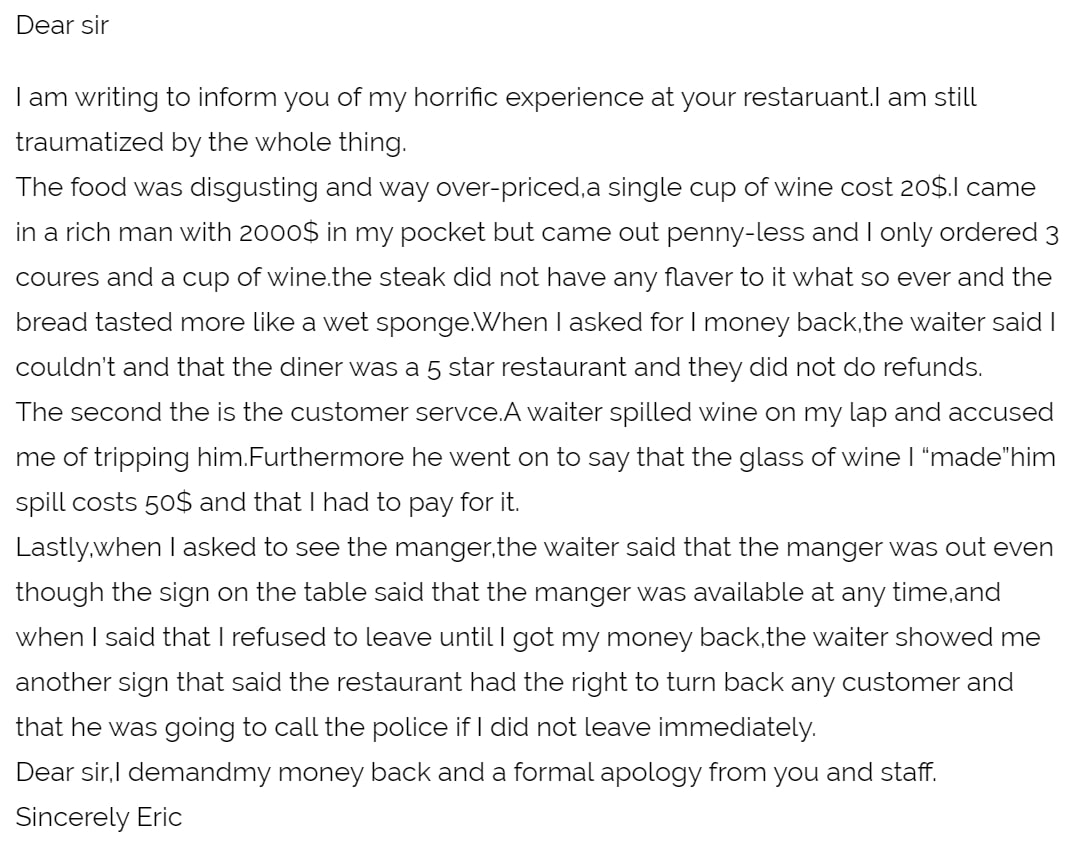
Examiner Assessment Scale
It's really good practice for you to mark other students' writings in the style of an examiner. So, open this assessment scale or if you prefer writing by hand, print off this hard copy assessment scale. Then, complete them based on the answer above.
CAE Letter Sample Answer 2 With My Comments
Before you read my corrections, make sure you have tried to find the mistakes on the answer above and then compare your mistakes with the ones I found below.
Sorry, this section is available for higher-level members only. Register/upgrade here to access >>
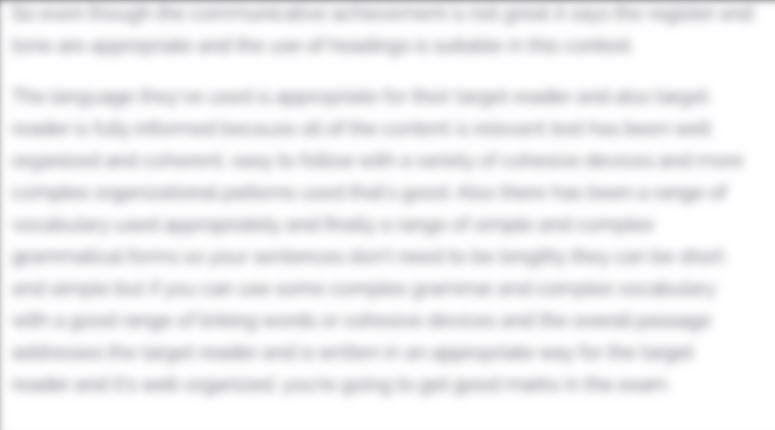
Examiner Assessment Scale Template With My Comments
Have you completed an assessment of the sample letter? Good. Now you should compare your assessment with my assessment below.
Sorry, you are not currently able to access this section. Register or upgrade your membership to access now >>
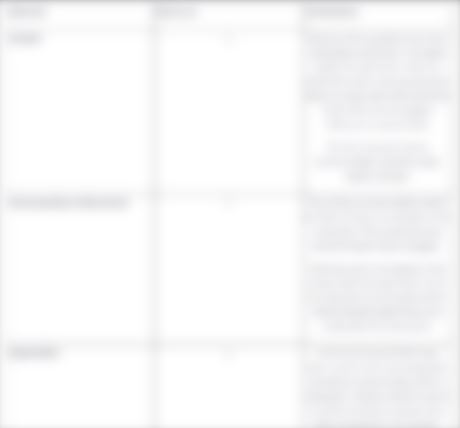
C1 Letter - Pass or Fail
The marks I have given this letter are:
Content: 3
Communicative Achievement: 2
Organisation: 3
Language: 3
That is a total of 11 out of a possible 20 marks. In the exam you need to get 24/40 or average 12 for both part 1 and part 2 of the writing test in order to pass this paper at a C1 level. Remember, you do not need to pass every exam paper in order to attain your C1 Advanced certificate. Nevertheless, I tell my students they should really be averaging 70% or higher in practice tests before applying to do the exam. This is because many students comment that the actual exam is harder than the tests they do beforehand.
I was uncertain whether this letter deserved a pass mark or not. It was borderline in my opinion, but I judged it slightly more harshly because from what I've heard, the examiners take no prisoners.
CAE Exam Tip: sorry, this tip is available for higher-level members only. Register/upgrade here to access now >>
CAE Formal Letter Vocabulary
CAE Formal Letter Tip: In formal writing, we tend to use nouns more than verbs.
Introduction
"Dear Mr/Mrs/Ms/Sir/Madam"
"Thank you kindly for your letter"
"I am writing with regard to"
I am writing to address your previous letter"
"I am writing to express my + noun"
Main paragraphs
"I (strongly) agree/disagree"
"I advise you to"
"Please reconsider..."
"Your letter states...however/nevertheless, this..."
Justifying
"thus/therefore/because/due to"
Reassuring
"You can rest assured that..."
"You can be confident that..."
Recommending
"I highly/strongly recommend + verbing"
"I suggest that/+ verbing"
Conclusion
"I hope you look on this letter favourably"
"I hope you take this letter into consideration"
"Kind regards"
"I look forward to your (prompt) reply"
"Yours faithfully"
"Yours sincerely"
CAE Informal Letter Vocabulary
Introduction
"Dear Chris/Paul"
"Hi X"
"It's great to hear from you!"
"I'm so glad to hear from you"
"Thanks a lot for your letter"
"Sorry to hear..."
Main paragraphs
"I agree/disagree with..."
"I reckon you should..."
"You should definitely think again about + verbing..."
"Your said that you wanted to...but I think..."
Justifying
"because/so/to/in order to"
"Just imagine how amazing it will be."
Reassuring
"Have faith in..."
"Don't worry about..."
"You don't need to worry about..."
Recommending
"I definitely recommend + verbing"
"I suggest that/+ verbing"
"This is definitely the best option..."
"This is a great/amazing/wonderful...."
"You should..."
"Make sure you..."
"If I were you, I would + infinitive"
"There's no point + verbing"
Conclusion
"Take care"
"Speak soon"
"I hope this helps"
"Look forward to..."
"Many thanks"
"Can't wait to see you..."
"Lots of love. Roberto." (This would be for relatives or close friends).
What To Do Next
If you want to learn how to get top marks for every different CAE writing, you should definitely start my C1 Advanced Writing course from the beginning (if you haven't done this already). You will see examiners and my own critiques of other sample CAE answers as well as learning lots more tips and techniques. You also have the option of completing homework exercises.
You should also definitely read my book of CAE writing samples:
The book has 3 sample letters with my critique. It also has 18 other writings including 6 essays. What's more, you can read it for FREE with Kindle Unlimited. Take a look >>
Finally, you can submit your own writing to me via my CAE writing assessment service and if I have time I will try to mark it for you and give feedback.
Classroom Activities
Below are some tasks that you or your students can do in class or for homework. Click here for computer based instructions.
- Read this example letter question, then write a plan for it here.
- Print this answer and correct any mistakes you find on it.
- Compare your mistakes with the ones I identified here.
- Fill in this assessment scale with your marks and comments.
- How different is your assessment to mine?
- Print and continually update this form with my advice and tips from my website.
Homework
Watch the video below and complete the exercises:
Get Gold membership >> to complete the homework.
Did you enjoy this page?
Start my CAE course here >>
or
Register here to access the 'Next Page >>' link below...
Next Page >>



